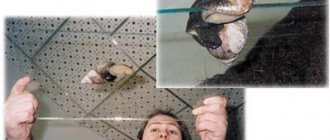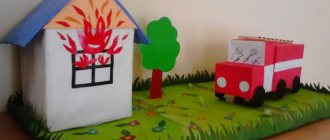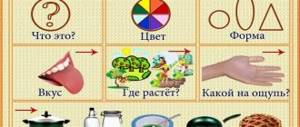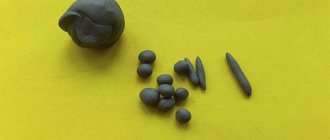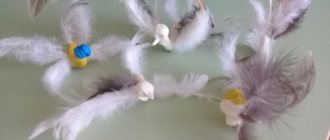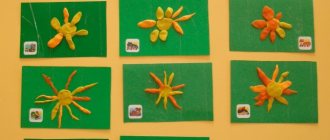The art of creating figures from dough has been known since ancient times. Even in ancient Rome, figurines of idols were made from dough for religious ceremonies. This type of activity became widespread in the 19th century.
In poor families, figurines were made from dough to decorate the Christmas tree. To prevent the dough from being destroyed by rodents, a large amount of salt was added to it. Then the craft was almost forgotten. And in the 20s of the twentieth century it was revived as an artistic craft.
Lesson plan for modeling from salt dough for children 6-7 years old. Theme: Elephant
Lesson plan for modeling from salt dough for children 6-7 years old.
Topic: Elephant.
Goal: sculpting a flat elephant from salt dough.
Tasks:
Educational:
to increase the competence of children by studying crafts made from salt dough, to introduce students to the technology of making a flat elephant from salt dough.
Educational:
cultivate interest in arts and crafts;
cultivate kindness towards people, love for animals;
provide an atmosphere of friendliness and comfort at work.
Educational:
develop fine motor skills, accuracy, creative thinking;
develop horizons, fantasy, imagination, sense of beauty;
develop the ability to empathize and give joy, the desire to give gifts to loved ones;
develop perseverance and patience.
Type of lesson: mixed (Conversation with explanation, practical work, independent work)
Type of lesson: Lesson for improving skills and abilities
Teaching methods: verbal: story, conversation, instruction; visual: display, demonstration of samples of salt dough products and working techniques, paintings, drawings. Methods of practical work. Reproductive method. Teaching technology: student-oriented technology of cooperation.
Participants: first year group of 6-7 years old, no more than 10 people
Equipment: pictures with elephants of different emotions, puzzles with elephants, templates of elephants of different shapes, world map, samples.
Materials and tools: salt dough, containers for dough, stacks, individual boards for working with dough, water, napkins, stacks, brushes.
Progress of the lesson:
- Organizational part.
Hello guys! Please take your seats. Today we will talk about gifts.
- Introduction to the topic
Do you like receiving gifts? (children's answers) Do you like giving gifts? (children's answers) It's so nice to watch when a friend is happy with your gift. How will you know whether he liked the gift or not? (children's answers) By the smile, by the words.
Look at the illustrations (Appendix 1) and tell me what emotions these 4 elephants experience? (children's answers) (joy, anger, fear, sadness)
What would you say if you were delighted with a gift? (children's answers)
What do you think is the difference between a gift from a store and one made with your own hands? (children's answers) When you make a gift, you think about who you will give it to, you try to make it beautiful so that your friend will like it. So, what do we put into a handmade gift? (children's answers) (time, materials, effort, patience, love, fantasy, imagination)
Do you know what a souvenir is? (children's answers) This is a small keepsake; it can be given for no reason, no holiday, just like that. The souvenir will remind your friend of you, of the trip from which it was brought, of an interesting place or event.
Close your eyes and imagine that you are traveling through Africa (the soundtrack of an African melody, sounds of nature and animals are playing).
What animals can you see in Africa? (children's answers)
One of these animals wants to give you a workout.
Physical education minute. The elephant shakes its head One, two, three - tilt forward,
One, two, three - now back. (Bends forward, backward.)
The elephant shakes its head -
He is happy to do exercises. (Chin to chest, then tilt your head back.) Although the exercise is short,
We rested a little.
Three nods of the head
One - get up, stretch, (Stretch.)
Two - bend over, straighten up, (Bent your backs, hands on your belt.)
Three - clap your hands three times, (Clap your hands.)
Three nods of the head. (Head movements.)
Four - arms wider, (Arms to the sides.)
Five - wave your arms, (Wave your arms.)
Six - sit down again. (Sit down.)
- Practice
If you put these puzzles together correctly, we will see what kind of elephants you can make from salt dough (Appendix 2. Puzzles are distributed according to the children’s abilities).
Tell us about the little elephant in your puzzles, what is he like (kind, cheerful, beautiful, how he is turned, complex or easy to sculpt, beautiful)
Could you make such an elephant? (children's answers) How can you simplify the elephant so that it is easier to make it? (children's answers) (make it monochromatic, use a template)
Choose an elephant template based on your strengths and abilities.
Where should we start working with salt dough? (children's answers)
From preparing the work uniform (we put on aprons), the workplace (we prepare a board, a rolling pin and a stack) and the dough itself. Our dough is kneaded, but before starting work it should be kneaded well.
While you are kneading a lump of dough, tell me what not to do. (children's answers) (the dough should not be put in the mouth, pressed to the face with clothes, or used for other purposes)
- Roll out the ball and press it onto the board with your palm. Roll out the flat cake. Check the thickness of the cake, it should be the same one or half centimeter. Place the template on the cake, check whether the figure fits into the cake. Cut out the elephant in a stack according to the template. We hold the template with our left hand, and with our right hand we cut with a stack, pressing it to the very edge of the template. We perform stack movements by pressing from top to bottom and along the blade, towards ourselves. If necessary, turn the board with the dough. We cut out sharp corners from the cake from different sides, without turning around in the corner. Separate off excess dough, checking to make sure cuts are made everywhere along the outline. Gather the leftovers into a ball and knead it. Check the elephant figure for integrity. Correct the contours by pressing them with light movements of your fingers. Make the necessary details from the remaining dough: an ear or trunk, eyes, jewelry, depending on the chosen template. Carefully remove the figure from the board onto a sheet of paper.
You can paint the elephant only after it has completely dried.
After work, you must wash your hands thoroughly so that the salt does not corrode the skin.
- Results
Give your elephant a name. (children's answers)
Where does he live? Show on a map or globe (In Africa, India, China or a zoo)
Do you know that in many countries elephants are considered sacred animals, honored and respected. Why do you think people have loved elephants since ancient times? (In India, elephants were used as pets, they helped people lift heavy loads)
Elephants are respected for their strength, wisdom, and calmness.
In Ancient China, the elephant symbolized a positive attitude towards life and the desire for development. So they attributed to him: insight; success in business prosperity; world; Love; ability to communicate with people.
In Africa, this animal means only positivity, and is associated with: dignity; intelligence; logic; intuition; patience; longevity; prosperity.
The most interesting symbolism of the elephant is present in the culture of Ancient India. Let's start with the fact that it is here that the elephant in the house is a symbol of: extraordinary wisdom; dignity; represents inner peace; symbolizes thoughtfulness; is a sign of prudence. Your homework will be to think and tell who you will give your souvenir in the form of an elephant and with what wishes.
Thanks for your creativity.
ANNEX 1
APPENDIX 2
